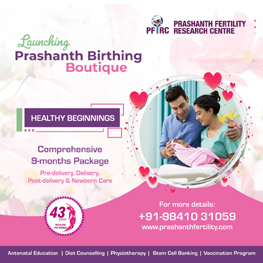New Techniques
BREAK THROUGH TECHNOLOGY FOR INFERTILE COUPLES
- Cytoplasmic transfer which is especially useful in repeated IVF failure and in women of older age.
- Microscopic testicular mapping for Azoospermia.
CYTOPLASMIC TRANSFER
Prashanth Super specialty hospital once again pioneers a revolutionary technique in Chennai, giving new hope to many infertile couples. Cytoplasmic transfer is the donation of healthy cytoplasm from fertile donors to patients eggs. This intricate technique is most beneficial in older patients whose eggs have lost the ability to function normally as well as younger patients with unexplained infertility and recurrent implantation failure. It is also beneficial to patients suffering from mitochondrial disorders.
The procedure itself involves the use of cytoplasm of young, fertile egg donors to rejuvenate the eggs of patients. This donated, fertile cytoplasm is rich in factors that are necessary for sustained embryo growth and implantation. This injection of “Fertile” cytoplasm into the patient’s eggs gives the embryo an energy boost which is often all that is needed for better embryo development and later implantation.
The egg donors are carefully selected and their eggs harvested for donation. Simultaneously, the recipient’s eggs are also harvested and prepared for sperm injection with her husband’s sperm. During the sperm injection, an enucleate volume of the egg donor’s cytoplasm is injected along with the sperm into the recipient’s eggs. The donated cytoplasm is a rich source of mitochondria and other factors that can be deficient in infertile couple’s eggs.
Cytoplasmic analysis of the donor’s remaining egg is then done to ensure that the donor’s chromosomes have not been accidentally transferred into the recipient’s eggs. The resulting embryo is checked for fertilization, embryo cleavage and blastulation. The resulting baby is genetically that of the treated couple. There have been over thirty babies born around the world from this technique.
Previous studies have shown that many patients whose embryos have previously failed to implant become pregnant after using this ground-breaking new technique. The developing embryo is often of better quality due to the restoring factors in the donated cytoplasm. In addition, women of advance age who previously had poor pregnancy outcomes with their own eggs alone have delivered healthy babies from this technique.
In February this year, the use of cytoplasmic transfers was approved in the United Kingdom in consultation with the Human Fertilization and Embryology Authority. Prashanth Super Specialty hospital is now offering this state of the art procedure overseen by their Australian collaboration. Couples suffering from unexplained infertility, recurrent implantation failure, highly fragmented embryos, advance aged patients and those with mitochondrial disorders are the best candidates for this new treatment method. Cytoplasmic transfer is a fresh new hope for infertile couples in India.
Women who previously had to use donor eggs because of poor or absent eggs due to endometriosis, previous surgeries for ovarian cysts and those in the over 38 to 40 age group, can now have babies with this new technique. Useful if donor eggs are unacceptable to some women who cannot accept a baby with genes that are not theirs and this is particularly so in the educated and higher socio economic group. Young patients who have had repeated IVF failures or recurrent miscarriages because of poor egg quality will also benefit by this technique. Cytoplasmic transfer is a boon for infertile couples.
NEWER TECHNOLOGY IN MALE INFERTILITY
Azoospermia is a condition in which there are no sperm seen in semen analysis even after pellet preparation. Some of these patients undergo testicular biopsy for diagnostic and therapeutic purposes. Until now biopsy was done only in a single site however recently it has been shown that even if the majority of the testis does not have spermatogenisis there can be focal areas of sperm production which can be missed with single site biopsy technique. Now we have started doing testicular mapping which is taking biopsy from multiple sites to enable us to identify these focal areas of sperm production. As the technique of assisted reproduction is advanced even a few sperms can be utilisedfor ICSI/IMSI. At Prashanth fertility centre we have started doing testicular mapping with the aid of an operating microscope. The advantage of this is the trauma to the testis is minimised and the incisions on the testis are small. With this technique we will be able to map the testis more extensively thus increasing the chance of finding these focal areas of sperm production.




